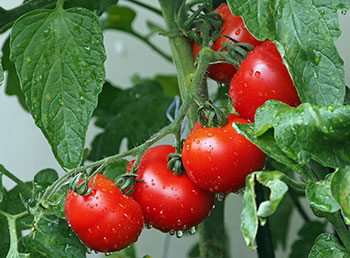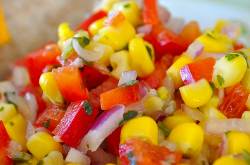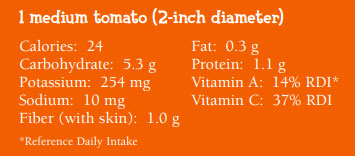Tomatoes - Buying, Storing, & Preparing
Fast Facts

- Arkansas tomatoes are available from May to October
- Tomatoes are high in potassium and vitamin C
- Tomatoes should be harvested when they are firm and changing color
The tomato is native to the Americas and was cultivated as early as 700 A.D. by the Aztecs and Incas. The conquistadors took seed to Europe in the 16th century and the tomato soon became popular in Mediterranean countries.
As the tomato gained popularity through Europe, it was given various names. The French
called it “The Apple of Love” and the Germans, “The Apple of Paradise.” The British
liked its brilliant red color but believed the tomato was poisonous. This same fear
existed in the United States until early in the 19th century.
Buying & Storing Tips
- Choose tomatoes that are firm and plump. Avoid those that are very soft, bruised, cracked or otherwise damaged.
- Ripe tomatoes are completely red or reddish orange (depending on the variety) and
give slightly to gentle palm pressure. - Mature-green tomatoes have quality similar to vine-ripened, if given proper conditions to ripen.
- Select unpackaged tomatoes or those packaged in perforated wraps. This allows for good air circulation, which is needed to ripen tomatoes.
- One pound has three medium or four small tomatoes that yield about 1½ cups of pulp.
Preparation Tips
- Fresh tomatoes can be served uncooked in salads or stewed, baked, broiled or microwaved.
- When freezing tomatoes, the skins should be removed because they become tough.
- When peeling ripe tomatoes, drop in boiling water for 30 to 60 seconds, then dip into
cold water. The skins will slide off.
- Check out our page Peeling Tomatoes the Easy Way to see it done!
- When canning, only use firm and ripe tomatoes. Overripe, soft tomatoes or tomatoes
picked from frost or disease-killed plants have less acid and may be unsafe to can.
- Check out our publication on canning tomatoes for more information.
Recipes
Quick Caprese Salad

Prep Time: 10 minutes
- 6 medium ripe tomatoes
- 4 ounces fresh mozzarella cheese
- 2 tablespoons extra-virgin olive oil
- 1 tablespoon balsamic or red wine vinegar
- 6 large basil leaves
- Salt and pepper to taste
- Cut tomatoes and mozzarella into bite-sized pieces.
- Stack basil leaves and roll into a cylinder. Cut into thin ribbons with kitchen shears or sharp knife. Sprinkle ribbons over the salad.
- Whisk together olive oil and vinegar. Drizzle dressing over the salad and sprinkle with salt and fresh ground pepper.
- Serve immediately.
Makes 6 servings
Nutritional Info Per Serving:
- Calories: 112
- Protein: 6 g
- Fat: 8 g
- Carbohydrates: 6 g
- Saturated fat: 3 g
- Fiber: 1g
- Cholesterol: 12
Summertime Corn and Tomatoes

- 1 cup sweet corn, drained
- 1/4 cup shredded cheddar cheese
- 1/4 cup finely chopped onions
- 1 teaspoon favorite herb and a dash of vinegar
- Dash of pepper
- 2 fresh medium-size tomato, chopped
- Mix together all ingredients in medium mixing bowl.
- Chill before serving to allow flavors to meld.
One serving contains: 141 calories; 15 gm cholesterol; 102 mg sodium; 15 gm carbohydrates; 342 mg potassium; 46 mcg folate; 115 mg calcium.
Fresh Tomato Sauce
Prep Time: 2 hours (includes inactive drain time)
- 3 pounds firm, ripe tomatoes, chopped
- 1/8 teaspoon salt
- 1 red onion, thinly sliced
- 2 cloves of garlic, finely chopped
- 6-8 fresh basil leaves, finely chopped
- 2 tablespoons extra virgin olive oil
- 1/8 teaspoon sugar
- Place tomatoes in covered saucepan with 1/8 teaspoon salt.
- Cook over medium heat for 5 minutes.
- Transfer to colander and let drain for one hour.
- Return drained tomatoes to the saucepan and add the onion, garlic, basil, olive oil, sugar and a dash of salt.
- Cover and bring to a boil over medium heat.
- Reduce heat and simmer for about 40 minutes or until the sauce has thickened.
- Remove from heat and process in a food processor or blender until smooth.
- Serve over pasta, rice or baked potato.
Makes 6 servings
Nutrition Information Per Serving:
- Calories: 84
- Protein: 2 g
- Fat: 5 g
- Carbohydrates: 10 g
- Saturated fat: 1 g
- Fiber: 3 g
- Cholesterol: 0 mg
- Sodium: 60 mg
Try this watermelon tomato salad!
Explore our website to find more recipes!
Nutrition Information
Vegetables are an important source of fiber and many nutrients. Although the actual amount of some of the nutrients present may seem small, their contribution is significant if two to three servings of vegetables are eaten daily. Below are the nutrients which supply five percent or greater of the Reference Daily Intake (RDI) per serving.

Interested in growing your own tomatoes? Check out these resources!